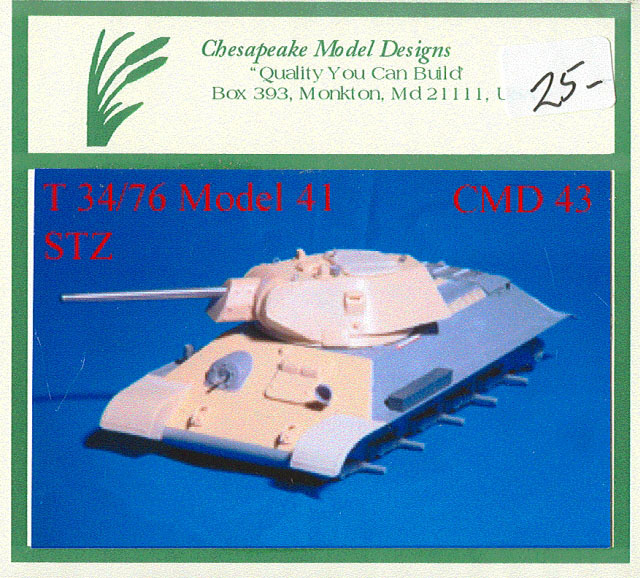Chesapeake Model Designs 1/35 Scale
Kit Number 43; T-34/76 Model 1941 STZ
by Cookie Sewell

30 parts (29 in light tan resin and one turned aluminum gun barrel);
price US$25
Advantages: much cleaner than the Zvezda kit, and provides suitable modification
parts and supplemental instructions to convert either DML T-34 Model 1941
kit to an STZ produced tank
Disadvantages: requires the modeler to do some work on his own!
Rating: Highly Recommended
Recommendation: For all Soviet WWII and "34" fans who want
something different
I have to plead guilty to being an avid T-34 fan (those of snide disposition
would probably claim it makes me an STFF or "Slobbering 34 Freak")
as I have followed a lot of its career and researched a good deal of its
early production difficulties and achievements. One of the more popular
subvariants of the early model T-34s (only the Germans used the stroke
76 designator; the Russians never did and only added a dash 85 for the
later variants with 85mm guns) for modelers due to its extreme detail
changes.
The T-34 began production at the Kharkov Steam Locomotive Factory No.
183 in December 1939. Later, in the summer of 1940, as orders began to
grow for the new tank, a new production line opened at the "Krasnoye
Sormovo" Factory No. 112. Finally, in 1941 a third line was added
at the Stalingrad Tractor Factory (STZ in Russian). Starting by assembling
about 100 T-34 Model 1941 tanks with L-11 guns produced from "knock-down"
kits supplied by Kharkov, this factory was to change over to mirror the
first two and produce an identical version of the Model 1941 tank with
F-34 gun.
This quickly fell apart after the Germans invaded in 1941, and the name
of the game soon became the production of the T-34 by the fastest possible
means. While Factory No. 183 was withdrawn to Nizhniy Tagil in October
1941, the STZ stayed put and soon became the backbone of the defensive
effort supporting the Stalingrad Front. Over the course of 1941-1942,
the factory managed to produce 3,670 T-34 Model 1941 tanks to support
the war effort.
But as the crunch for time began to impact them, STZ began to modify
the T-34 design to make it easier – and quicker – to build.
Not having the massive and impressive automatic welding jigs for the hull
as used in Nizhniy Tagil (which at their peak cut the time required to
assemble a T-34 hull to only 20 man-hours) STZ used a unique method of
notching the hulls to make it faster and more reliable for hand welding
to make the hulls in a hurry. These notches were at the front, rear and
top center of the hull sides.
They also changed the turret to make it easier to construct. Indents
were used at its lower front for alignment, the rear of the rolled sides
were left at a sharp angle with the entire rear plate bolted on, and the
recoil mechanism cover was left as a single plate (producing an angular
or "chisel" front to it) in order to avoid having to have another
step in bending the cover plate and cutting the sides to match a jig.
Due to a shortage of rubber, they also were the first factory to go to
an all steel cast wheel with internal rubber buffering. This was quickly
found to make the tank an extremely rough rider over any distance and
fatiguing to the crew from the noise and vibration; it was soon amended
to use a combination of rubber tired and steel wheels with the rubber
tires on the first and last road wheel stations.
CMD has done most of the basic work on the kit for the modeler, and all
the modeler needs to do other than use the parts in the kit is to make
the notched section on the upper hull and fit the notched front and rear
plates to the DML hull. This is not beyond the skills of most modelers,
and very detailed directions are provided for that.
The kit provides a complete turret shell with choice of early or late
hatches (again, by cutting corners on fancy items it speeded up production),
new recoil mechanism cover ("chisel nose"), a turned F-34 barrel,
and bow and stern plates; it also provides the short-term "applique"
armor sections for the front and lower glacis as well as new rounded fenders
and the simplified "hammerhead" tow hooks with spring keepers.
(For those who used the earlier Model 1940 kit, the CMD kit also provides
the later radiator intakes with longitudinal venting.)
The kit does not provide the standard production steel wheels, so the
modeler is on his own for those items. I have not tried to see if Tamiya
wheels fit on this kit, so cannot comment whether it is easier to use
them, Zvezda wheels, or after-market ones.
Overall this is a useful conversion kit, and one that is up to the high
standards of CMD.
Thanks to Bill Miley of CMD for the review sample.
Cookie Sewell
|